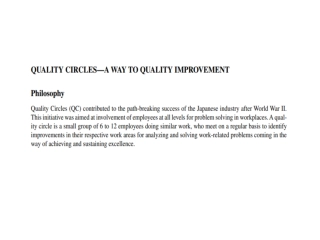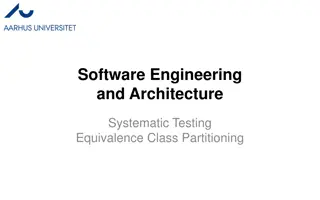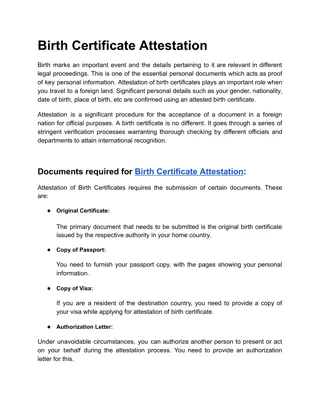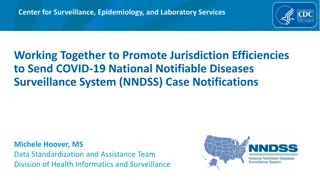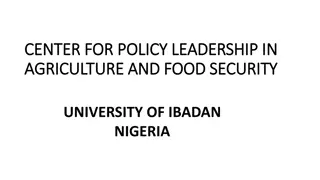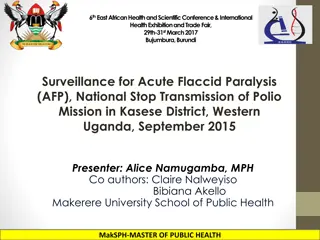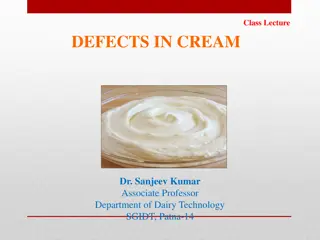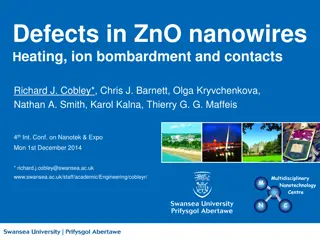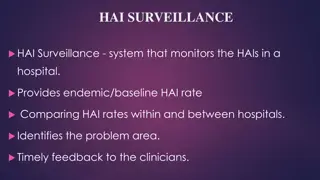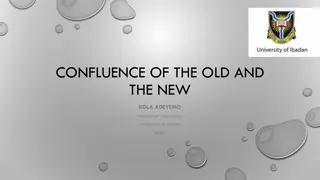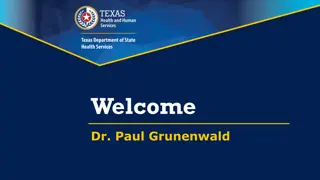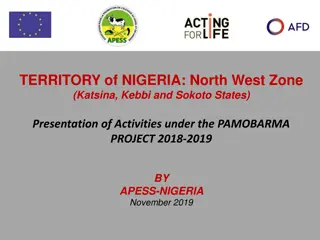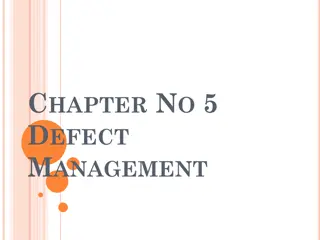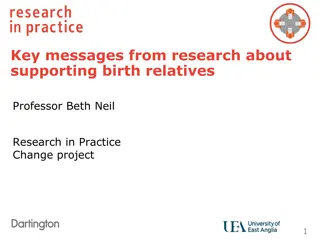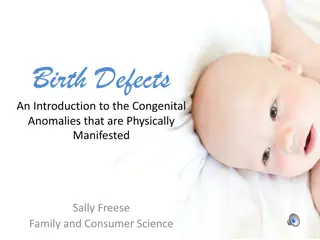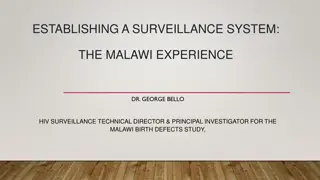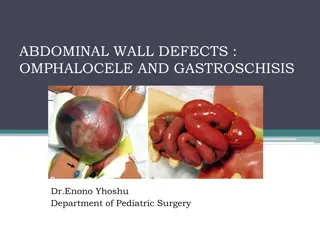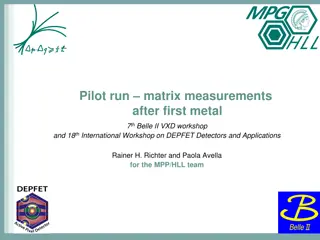Birth Defects Surveillance in Nigeria: Ibadan Experience - Overview and Team Members
Dr. Adejumoke Idowu Ayede shares insights on Birth Defects Surveillance in Nigeria with a focus on the Ibadan Experience. The outline highlights the twin institutions involved, strategies for group establishment, baseline data collection, and immediate next plans. The team members from various specialties contribute to this important initiative, aiming to improve birth defect surveillance and care in the region.
Download Presentation

Please find below an Image/Link to download the presentation.
The content on the website is provided AS IS for your information and personal use only. It may not be sold, licensed, or shared on other websites without obtaining consent from the author. Download presentation by click this link. If you encounter any issues during the download, it is possible that the publisher has removed the file from their server.
E N D
Presentation Transcript
Birth Defects Surveillance in Birth Defects Surveillance in Nigeria: Ibadan Experience Nigeria: Ibadan Experience By: Dr Adejumoke Idowu AYEDE Department of Paediatrics College of Medicine, University of Ibadan And University College Hospital, Ibadan, Nigeria.
The outline The outline The twin Institutions The sub groups Strategies for group establishment Baseline data collection Baseline data publications Meeting with FMOH Birth defect surveillance as part of agenda for Children with Special Needs sub-committee of CHTWG of FMOH Immediate next plans
Team Members (2015) Other members Paediatric Cardiology Team: Prof S.I Core Members Dr. A. I. Ayede: Team Chair Dr. A. O. Adeleye: Team Co-Chair Dr. A. A. Olusanya: Team Secretary Omokhodion Sub-team Leader Dr O.O Ogunkunle Dr A. Adebayo Endocrine and Genetics Team: Dr Ashubu Sub-team Leader Paediatric Surgical Team: Dr Lawal Sub-team Leader Dr Olulana DrOgundoyin
Other members contd Other members cont d Ophthalmology Prof. Baiyeroju Paediatric Nephrology Team: Dr. Ada Asinobi Sub-team Leader Dr. Olusanya Dr. V. Joel- Medewase Sub-team Leader Sub-team Leader Dr Ademola OLA Oluyoro, Ibadan Cranio-Facial Surgery Dr. Olusanya Sub-team Leader Prenatal Screening Team Dr. G. Ogbole Urology Dr. S. Adebayo Sub-team Leader Dr. Takure Policy Makers Dr Afolabi K. Reproductive Health Unit FMOH Dr James Child Health Unit FMOH Child Health FMOH Sub-team Leader Dr. Akinmoladun Prof. A. Agunloye Obstetrics Team Prof. O. Olayemi O Sub-team Leader Dr Mohanson- Bello Dr A. Adekanibi
Strategies for group establishment Strategies for group establishment Shared vision Goals and objectives Monthly token contributions from members Initial monthly meetings and later less frequently Proposal and publication targets Institutional involvement and seeking for support Chair and Co-Chair Joined ICBDSR Co-Chair attended Tanzania meeting 2016
Baseline burden data collection and Baseline burden data collection and publications publications Afr. J. Med. med. Sci. (2016) 45, 421-431 Implementing fetal anomaly ultrasound screening programs in developing countries: strategies, challenges, lessons and recommendations from Ibadan, Nigeria AO Adeleye1, AI Ayede2, JA Akinmoladun3, GI Ogbole3, AM Agunloye3, AA Olusanya4, OO Ogunkunle2, AO Asinobi2, TA Lawal5, BA Olusanya6, OF Ashubu2, AOA Adekanbi7, SI Omokhodion2, AO Adeyinka3and TO Alonge8. Afr. J. Med. med. Sci. (2016) 45, 433-438 Congenital anomalies in Ibadan, Nigeria AI Ayede1, AO Adeleye2, AA Olusanya3, TA Lawal4, BA Olusanya5, OO Ogunkunle1, AO Asinobi1, BE Adebayo1, OO Jarrett1, DI Olulana4, OO Ogundoyin4, OF Ashubu1, IO Morhason-Bello6, AOA Adekanbi6, AM Baiyeroju5 , VI Joel-Medewase7, AD Ademola1, O Olayemi6, GI Ogbole8, JA Akinmoladun8 , AM Agunloye8, OO Akinrinoye1, AO Takure9, OB Oyewole1, OM Oluwatosin10 and SI Omokhodion1
Baseline burden data collection and Baseline burden data collection and publications 2 publications 2 Afr. J. Med. Med. Sci. (2017) 46, 49-55 Congenital paediatric surgical cases in Ibadan: patterns and associated malformations TA Lawal1,2, AO Adeleye1,3, AI Ayede4,5, OO Ogundoyin1,2, DI Olulana1,2, AA Olusanya6,7, BA Olusanya8,9, OO Jarrett4,5, AO Asinobi4,5, OF Ashubu5and OO Busari5 Afr. J. Med. Med. Sci. (2017) 46, 259-265 Congenital craniofacial anomalies: The experience of a sub-Saharan African tertiary hospital. AA Olusanya1, AO Adeleye2, AI Ayede3, TA Lawal4, BA Olusanya5, OO Ogunkunle3, AO Asinobi3, VI Joel-Medewase6, AM Agunloye7, OF Ashubu3, AI Michael8, OM Oluwatosin8and O Olayemi9
Joined ICBDSR and Colaborated with CDC USA ICBDSR Lorenzo Botto Boris Groisman Pierpaolo Mastroiacovo- Director of the Coordinating Centre of International Clearinghouse for Birth Defects Surveillance and Research, Rome, Italy
Proposed sites Ibadan- capital of Oyo State with a population of ~3 million, and 4.5% births per year. Total Births Main Maternity Hospitals Served Area classification per year University College Hospital 2000- 3,000 Low and high socioeconomic status Adeoyo Maternity Hospital 4000- 6,000 Low and high socioeconomic status Oluyoro Catholic Hospital 1000 -2,000 Low and high socioeconomic status Up to 50% in some rural Home births communities, 20-30% in peri-urban Low and middle socioeconomic status /urban
Project Objectives: Project Objectives: Determine the prevalence of neural tube defects, oro-facial clefts, talipes equinovarus, limb deficiencies, anorectal malformations, hypospadias, gastroschisis and omphalocoele in the three main birthing hospitals in Ibadan, Nigeria. Determine any apparent clinical and or socio-demographic associations with the prevalence of each of these defects. Quantify the human and financial resources required to provide medical care for the affected children.
Inclusion / Exclusion Criteria Inclusion / Exclusion Criteria Inclusion Criteria Live births up to hospital discharge or 7 days of age / still births occurring in the selected hospitals regardless of mother s place of residence Babies weighing 1000g at birth Exclusion criteria Referrals from other hospitals or from the community for babies not born in the participating hospitals Babies born before arrival (BBA) (only babies actually delivered within the hospital premises will be included)
Defects to be included Defects to be included Neural Tube Defects: Anencephaly Craniorachischisis Encephalocele Spina bifida Orofacial Clefts: Cleft palate alone Cleft palate Bilateral Cleft Lip Cleft lip, bilateral Cleft Lip, specified as unilateral Cleft Hard Palate with Bilateral Cleft lip MSS: Talipes Equinovarus Limb reduction deficiencies Anorectal malformations Anal atresia with vestibular fistula Anal atresia Gastroschisis Omphalocele Hypospadias Imperforate anus
OBJECTIVES I. To provide an orientation on Birth Defect Surveillance II. To determine specific activities (advocacy, promotional, curative, surveillance) being implemented by different stakeholders in the country III. To obtain general consensus and a way forward on the feasibility of establishing Birth Defect Surveillance in Nigeria.
HIGHLIGHT The highlight of the meeting were presentations by the participants, group work and plenary which brought the: I. II. Challenges III. Ethical considerations IV. Existing opportunities V. Recommendation VI. Articulated next steps Burden
KEY RECOMMENDATIONS I. Develop a strategic document on Birth Defect Surveillance II. Constitute a core group to develop draft of action protocol, tools for training and surveillance III. Institutionalize Birth Defect Surveillance in two facilities in each of the six geopolitical zones IV. Develop health information management system for Birth Defect Surveillance
ACTIONS Action plan Protocols Tools
Current success stories: Current success stories: Buy in by FMOH FMOH CHTWG rejuvenated Sub-Committee on children with special needs in which birth defects surveillance is a najour components
What are our current needs? What are our current needs? Grant More institutional support Dedicated staff
THANK YOU THANK YOU


